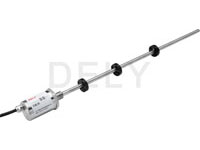
Hotline:
0750-6163878
( Ms Zhang )
Phone: 18929003382
Fax: 0750-6703782
Address: East Industrial Zone, Huicheng Town, Xinhui District, Jiangmen city
Displacement sensor manufacturer: where can the inclination sensor be applied?
From the perspective of practical application, the situation of inclination sensor in military, civil and industrial fields is also very different. Industrial grade sensors are the way to break the situation.
As far as industrial grade sensors are concerned, the distance between domestic products and foreign products is Z large. On the one hand, limited by the domestic production level, the consistency and stability of products are not good; On the other hand, it is related to the neglect of inclination sensor in China. When tackling key technical problems, the host often takes the lead, and the sensor is basically used as a supporting role. When introducing foreign equipment, the introduction method of complete machine is often used, and there is little opportunity for domestic parts. For nuclear, chemical and electric power operations, complete sets of equipment are usually directly input, and these equipment are basically equipped with appearance and inclination sensors. In the bidding of many projects, the builder also clearly requires that advanced instruments and sensors should choose products of foreign brands.
Since the inclination sensor accounts for a relatively low proportion of the overall equipment value, manufacturers prefer to choose foreign brands with higher quality. For example, at 300000 yuan for a machine tool, the price of the acceleration sensor is only a few thousand yuan. Machine tool manufacturers are not willing to take risks to choose domestic sensor brands, which makes domestic sensor manufacturers in a state of hunger for a long time, short of operation and use and trial and error growth opportunities.
As far as the military is concerned, the inclination sensor is the facial features of missiles, rockets and various munitions, which is the benchmark competitiveness of all weapons. The new budget allocated by the Ministry of defense for the joint fighter F35 still includes the discussion of sensors and cyber warfare. The army has always regarded sensors as the key center of future intelligent warfare. In the article at the beginning of this year, Milly's statement of "higher war" was quoted. In this concept, "the effect of ubiquitous sensors is to make the enemy die faster". In the war for 2035, the U.S. military envisioned seven kinds of intelligence around sensors, including visual intelligence, communication intelligence, etc., and artificial intelligence is just one of them. From this point of view, talking about artificial intelligence in vain, for the manufacturing industry, is very simple, creating a false impression of vigorous virtual fire; We only need to talk about intelligent production around the sensor to get closer to the inside story of intelligence.
The military industry has always attached great importance to the use of sensors, and even spared no cost in planning and production, with high value. As a sensor of military products, to seek whether it is the top policy, economy is the second. It often selects higher production lines and process methods, which is inevitable to cost labor and materials. The production of military sensors is different from that of industrial sensors.
Civilian sensors are very different from military products. Its primary consideration is economy, and it is necessary to strictly control the production cost and the rate of defective products. At present, in the field of medium and high-level sensor manufacturing, China has no advantages in intellectual property, equipment and materials, and the cost is high. But in recent years, in some limited areas, this situation is gradually changing. For example, with the widespread use of Apple LED high fidelity headphone TWS, the opening of acoustic sensors has also increased, showing a number of enterprises, such as Goethe, Ruisheng, etc.

Single and double axis high-precision digital output inclination sensor, viewpoint module, viewpoint sensor
In practice, the rapid opening of civil sensors gives an important enlightenment to industrial sensors, that is, the application will drive the opening of sensors, and many applications will drive the opening of sensors. In the past, acoustic sensors were exclusively under Lou's brand, but with the shipment of many earphones from Weifang goer acoustics, it naturally advocated to fight against the MEMS sensors in which Z is the key (this sensor uses a semiconductor process different from traditional mechanical processing). Despite the initiative to launch many patent litigation wars, Lou is still retreating, and China's acoustic sensors are a corps of drums. Similarly, in the new category, China's sensors often find pride because they rely on the huge domestic market. With the rise of life and great health, biosensors for measuring blood pressure and blood glucose are also booming, which is also the opportunity for sensors in China. Linear displacement sensor
This has inspired a lot about the deep-rooted industrial sensors for many years. Of course, the three different categories of sensors have their own similarities. Foreign sensor manufacturers often take all three, because only in this way can we end the big planning effect. This happens to be the short board of sensors in our country.
Source: displacement sensor manufacturer http://www.clic-conference.com